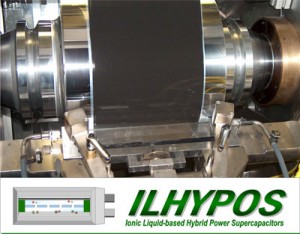
The search for a new clean energy increases worldwide as the sources of natural energy diminish. The transport sector is especially vulnerable, by the decline in oil reserves, at the time when number of cars on our roads steadily increases.
With the increase of the number of vehicles there is a corresponding increase in pollution in our environment. To overcome some of these problems in the transport sector the car manufacturers have turned to building hybrid and electric vehicles.
The first generation of electric vehicles had limited operating distance, poor acceleration and poor battery life. One of the most promising technologies to tackle these problems and make these vehicles more efficient and cleaner is being developed by the European project ILHYPOS. Here, new accumulation system – the ILHYPOS supercapacitor, is research which can improve performance, power, efficiency and increase the life of the batteries, which in the future will be lithium.
Rather than operate as a main battery, supercapacitors are more commonly used as memory backup to bridge short power interruptions. Another application is improving the current handling of a battery. The supercapacitor is placed in parallel to the battery terminal and provides current boost on high load demands. The supercapacitor should also find a ready market for portable fuel cells to enhance peak-load performance. Because of their ability to rapidly charge, large supercapacitors are used for regenerative braking on electric vehicles.
The supercapacitor can be recharged and discharged virtually an unlimited number of times. Unlike the electrochemical battery, there is very little wear and tear induced by cycling and age does not affect the supercapacitor much.
Prof. Mastragostino has been a key researcher in the development of the materials and cells needed for the production of the supercapacitor for the ILHYPOS project. This included the choice of carbon material used and a more environmentally friendly product in the form of the ionic liquid. Ionic liquid, a saline liquid at room-temperature, with an elevated ionic conductivity, allowing ions to pass in various electro-chemical systems in a supercapacitors and also in lithium batteries as well as in fuel cells.
The ionic liquid is a non-toxic substance, stable in all conditions and hence not affecting the environment. This makes it a completely “green” product, being environmentally friendly at every stage of its use, from the time that it is put in the supercapacitor to the moment it is recycled.
Testing of the actual manufacture process of ILHYPOS supercapacitor, has been performed by Arcotronics, which has been in charge of work on cells design, assembly and pilot line preparation and is involved in production machinery design and assembly. It has developed experience in electrochemical devices (supercapacitor, li-ion cell) assembly methodology and their target has been to assemble supercapacitors starting from the raw material developed and produced by the University team. The machines used for the production are already in situ, giving these components a more competitive edge in the market. The importance of testing the production of supercapacitors on the machinery in situ at Arcotronics, is to show that it’s possible to produce supercapacitors using techniques already employed for the production of lithium batteries, and to show that the supercapacitor can be manufactured on a large scale.
has been in charge of work on cells design, assembly and pilot line preparation and is involved in production machinery design and assembly. It has developed experience in electrochemical devices (supercapacitor, li-ion cell) assembly methodology and their target has been to assemble supercapacitors starting from the raw material developed and produced by the University team. The machines used for the production are already in situ, giving these components a more competitive edge in the market. The importance of testing the production of supercapacitors on the machinery in situ at Arcotronics, is to show that it’s possible to produce supercapacitors using techniques already employed for the production of lithium batteries, and to show that the supercapacitor can be manufactured on a large scale.
With a success of this prototype, researchers are preparing to make their supercapacitors readily available and their work will soon help to build much more powerful, efficient and greener engines for electric vehicles. It is now up to the vehicle manufacturers to produce them on a larger scale, so lowering production costs and making them readily accessible.



